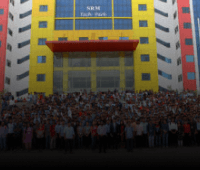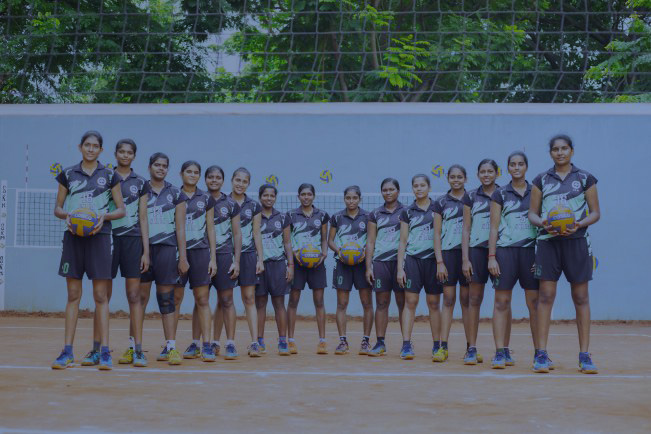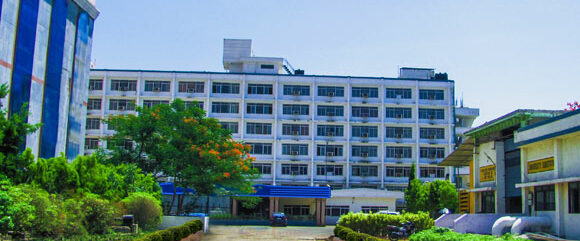- RETENTION POLICY
20.1 ELECTRONIC DOCUMENTS
- Electronic Mail: Not all email needs to be retained, depending on the subject
- As SRMIST use google workspace for education fundamental for email solution, all its policies and restrictions are applicable from time to time.
- Staff will not store or transfer SRM Institute of Science and Technology-related e-mails on non-work-related computers except as necessary or appropriate for SRM Institute of Science and Technology purposes.
- Staff will not send confidential/proprietary SRM Institute of Science and Technology information to outside sources.
- Staff with more than 5 GB in their e-mail account will be unable to send or receive messages until the size of their account is reduced.
- Electronic Documents: including Microsoft Office Suite and PDF files.
Retention of the files depends on the subject matter. The length of time the files should be retained is based on the content of the file and the category under the various sections of this policy. The maximum period that a file should be retained is six years. Files that the employee deems vital to the performance of his or her job should be stored in the central repository in electronic form. The individual Staff will conduct annual reviews of all files (e.g., Word, pdf, etc. documents) and delete all those they consider unnecessary or outdated.
20.2 RECORD RETENTION AND DESTRUCTION POLICY
- PURPOSE
The purpose of this policy is to ensure that necessary records and documents of are adequately protected and maintained and to ensure that records are no longer needed by SRM Institute of Science and Technology or are of no value are discarded at the proper time. This policy is also for the purpose of aiding employees of SRM Institute of Science and Technology in understanding their obligations in retaining electronic documents – including e-mail, web files, text files, sound and movie files, PDF documents, and all Microsoft office or other formatted files.
2) POLICY
This policy represents the SRM Institute of Science and Technology’s policy regarding the retention and disposal of records and the retention and disposal of electronic documents.
3) ADMINISTRATION
Attached as Appendix A is a Record Retention Schedule that is approved as the initial maintenance, retention and disposal schedule for physical records of SRM Institute of Science and Technology and the retention and disposal of electronic documents. The Registrar (the “Administrator”) is the officer in charge of the administration of this policy and the implementation of processes and procedures to ensure that the Record Retention Schedule is followed. The Administrator is also authorized to make modifications to the Record Retention Schedule from time to time.
4) SUSPENSION OF RECORD DISPOSAL IN EVENT OF LITIGATION OR CLAIMS
In the event SRM Institute of Science and Technology is served with any subpoena or request for documents or any employee becomes aware of a governmental investigation or audit concerning SRM Institute of Science and Technology or the commencement of any litigation against or concerning SRM Institute of Science and Technology, such employee shall inform the Administrator and any further disposal of documents shall be suspended until such time as the Administrator determines. The administrator shall take such steps as is necessary to promptly inform all staff of any suspension in the further disposal of documents.
5) APPLICABILITY
This policy applies to all physical records generated in the course of SRM Institute of Science and Technology’s operation, including both original documents and reproductions. It also applies to the electronic documents described above.
This policy was approved by the Board of Management of SRM Institute of Science and Technology.
20.3 APPENDIX A ‑ RECORD RETENTION SCHEDULE
The Record Retention Schedule is arranged as follows:
SECTION TOPIC
- Accounting and Finance
- Contracts
- Corporate Records
- Correspondence and Internal Memoranda
- Grant Records
- Insurance Records
- Legal Files and Papers
- Miscellaneous
- Payroll Documents
- EPF Documents
- Personnel Records
- Property Records
- Tax Records
- Contribution Records
- Programs & Services Records
- Fiscal Sponsor Project Records
- Academic Records
- Admission Records
- Records pertaining to the office of the controller of Examination
- ACCOUNTING AND FINANCE
Record Type | Retention Period |
Accounts Payable ledgers and schedules | 7 years |
Accounts Receivable ledgers and schedules | 7 years |
Annual Audit Reports and Financial Statements | Permanent |
Annual Audit Records, including work papers and other documents that relate to the audit | 7 years after completion of audit |
Annual Plans and Budgets | 2 years |
Bank Statements and Canceled Checks | 7 years |
Employee Expense Reports | 7 years |
General Ledgers | Permanent |
Interim Financial Statements | 7 years |
Notes Receivable ledgers and schedules | 7 years |
Investment Records | 7 years after sale of investment |
Credit card records (documents showing customer credit card number) | 2 years |
- Credit card record retention and destruction
A credit card may be used to pay for the following SRM Institute of Science and Technology products and services:.
All records showing customer credit card number must be locked in a desk drawer or a file cabinet when not in immediate use by the staff.
If it is determined that information on a document, which contains credit card information, is necessary for retention beyond 2 years, then the credit card number will be cut out of the document.
2. CONTRACTS
Record Type | Retention Period |
Contracts and Related Correspondence (including any proposal that resulted in the contract and all other supportive documentation) | 2 years after expiration or termination of contract if no litigation |
3. CORPORATE RECORDS
Record Type | Retention Period |
Corporate Records (minute books, signed minutes of the Board and all committees, corporate seals, articles of incorporation, bylaws, annual corporate reports) | Permanent |
Licenses and Permits | Permanent |
4. CORRESPONDENCE AND INTERNAL MEMORANDA
General Principle: Most correspondences and internal memoranda should be retained for the same period as the document they pertain to or support. For instance, a letter pertaining to a particular contract would be retained as long as the contract (2 years after expiration) lasts. It is recommended that the records that support a particular project be kept with the project and take on the retention time of that particular project file.
Correspondence or memoranda that do not pertain to documents having a prescribed retention period should generally be discarded sooner. These may be divided into two general categories:
- Those pertaining to routine matters and having no significant, lasting consequences should be discarded within two years. Some examples include:
- Routine letters and notes that require no acknowledgment or follow‑up, such as notes of appreciation, congratulations, letters of transmittal, and plans for meetings.
- Form letters that require no follow‑up.
- Letters of general inquiry and replies that complete a cycle of correspondence.
- Letters or complaints requesting specific action that have no further value after changes are made or action taken (such as name or address change).
- Other letters of inconsequential subject matter or that definitely close correspondence to which no further reference will be necessary.
- Chronological correspondence files.
Please note that copies of interoffice correspondence and documents where a copy will be in the originating department file should be read and destroyed, unless the information provides reference to or direction to other documents and must be kept for project traceability.
- Those pertaining to non‑routine matters or having significant lasting consequences should generally be retained permanently.
5. GRANT RECORDS
Record Type | Retention Period |
Original grant proposal | 7 years after completion of grant period |
Grant agreement and subsequent modifications, if applicable | 7 years after completion of grant period |
All requested IRS/grantee correspondence including determination letters and “no change” in exempt status letters | 7 years after completion of grant period |
Final grantee reports, both financial and narrative | 7 years after completion of grant period |
All evidence of returned grant funds | 7 years after completion of grant period |
All pertinent formal correspondence including opinion letters of counsel | 7 years after completion of grant period |
Report assessment forms | 7 years after completion of grant period |
Documentation relating to grantee evidence of invoices and matching or challenge grants that would support grantee compliance with the grant agreement | 7 years after completion of grant period |
Pre-grant inquiry forms and other documentation for expenditure responsibility grants | 7 years after completion of grant period |
Grantee work product produced with the grant funds | 7 years after completion of grant period |
6. INSURANCE RECORDS
Record Type | Retention Period |
Annual Loss Summaries | 10 years |
Audits and Adjustments | 3 years after final adjustment |
Certificates Issued to SRM Institute of Science and Technology | Permanent |
Claims Files (including correspondence, medical records, injury documentation, etc.) | Permanent |
Group Insurance Plans ‑ Active Employees | Until plan is amended or terminated |
Group Insurance Plans – Retirees | Permanent or until 6 years after death of last eligible participant |
Inspections | 3 years |
Insurance Policies (including expired policies) | Permanent |
Journal Entry Support Data | 7 years |
Loss Runs | 10 years |
Releases and Settlements | 25 years |
7. LEGAL FILES AND PAPERS
Record Type | Retention Period |
Legal Memoranda and Opinions (including all subject matter files) | 7 years after close of matter |
Litigation Files | 1 year after the matter came to an end |
Court Orders | Permanent |
Requests for Departure from Records Retention Plan | 10 years |
8. MISCELLANEOUS
Record Type | Retention Period |
Consultant’s Reports | 2 years |
Material of Historical Value (including pictures, publications) | Permanent |
Policy and Procedures Manuals – Original | Current version with revision history |
Policy and Procedures Manuals ‑ Copies | Retain current version only |
Annual Reports | Permanent (one or two copy to reference) |
9. PAYROLL DOCUMENTS
Record Type | Retention Period |
Employee Deduction Authorizations | 4 years after termination |
Payroll Deductions | Termination + 7 years |
W-2 and W-4 Forms | Termination + 7 years |
Garnishments, Assignments, Attachments | Termination + 7 years |
Labor Distribution Cost Records | 7 years |
Payroll Registers (gross and net) | 7 years |
Time Cards/Sheets | 2 years |
Unclaimed Wage Records | 6 years |
10. EPF, PENSION DOCUMENTS AND SUPPORTING EMPLOYEE DATA
General Principle: EPF documents and supporting employee data shall be kept in such a manner until the employee retires – or remarked
Record Type | Retention Period |
Retirement and connected Records | 2 years |
11. PERSONNEL RECORDS
Record Type | Retention Period |
Commissions/Bonuses/Incentives/Awards | 7 years |
EEO‑ I /EEO‑2 ‑ Employer Information Reports | 2 years after superseded or filing (whichever is longer) |
Employee Earnings Records | Separation + 7 years |
Employee Handbooks | 1 copy kept permanently |
Employee Medical Records | Separation + 6 years |
Employee Personnel Records (including individual attendance records, application forms, job or status change records, performance evaluations, termination papers, withholding information, garnishments, test results, training and qualification records) | 6 years after separation |
Employment Contracts – Individual | 7 years after separation |
Employment Records ‑ Correspondence with Employment Agencies and Advertisements for Job Openings | 3 years from date of hiring decision |
Employment Records ‑ All Non‑Hired Applicants (including all applications and resumes ‑ whether solicited or unsolicited, results of post‑offer, pre‑employment physicals, results of background investigations, if any, related correspondence) | 2-4 years (4 years if file contains any correspondence which might be construed as an offer) |
Job Descriptions | 3 years after superseded |
Personnel Count Records | 3 years |
Forms I-9 | 3 years after hiring, or 1 year after separation if later |
12. PROPERTY RECORDS
Record Type | Retention Period |
Correspondence, Property Deeds, Assessments, Licenses, Rights of Way | Permanent |
Original Purchase/Sale/Lease Agreement | Permanent |
Property Insurance Policies | Permanent |
13.TAX RECORDS
General Principle: SRM Institute of Science and Technology must keep an account or record of the gross income, deductions, credits, or other matters required to be shown in any such return.
These documents and records shall be kept for as long as the contents thereof may become material in the administration of federal, state, and local income, franchise, and property tax laws.
Record Type | Retention Period |
Tax-Exemption Documents | Permanent |
IRS Rulings | Permanent |
Excise Tax Records | 7 years |
Payroll Tax Records | 7 years |
Tax Bills, Receipts, Statements | 7 years |
Tax Returns ‑ Income, Franchise, Property | Permanent |
Tax Workpaper Packages ‑ Originals | 7 years |
Sales/Use Tax Records | 7 years |
Annual Information Returns – Federal and State | Permanent |
IRS or other Government Audit Records | Permanent |
14.CONTRIBUTION RECORDS
Record Type | Retention Period |
Records of Contributions | Permanent |
SRM Institute of Science and Technology’s or other documents evidencing terms of gifts | Permanent |
15.PROGRAM AND SERVICE RECORDS
Record Type | Retention Period |
{Insert Types of Programs and Services} | 7 years |
SRM Institute of Science and Technology convening | Permanent (1 copy only) |
Research & Publications | Permanent (1 copy only) |
16.FISCAL SPONSOR PROJECT RECORDS
Record Type | Retention Period |
Sponsorship agreements | Permanent |
17.ACADEMIC RECORDS
Sl. No. | Type of Record | Document Type | Retention Period | Record Disposition |
1 | Academic Calendar | E- Document | 2 year | Archieved On Completion of the current Academic year |
2 | Student Admission / Readmission / Transfer | E- Document/ Paper | N+2 years | Digital copies are available always in Student Information System and Paper Copies are stored in Record room |
3 | Regulations | E- Document | 10 Years / Until the Last student graduated | |
4 | Curriculum and Syllabus | E- Document | 10 Years / Until the Last student graduated | |
5 | Student Attendance Records | E- Document | Permanent | Digital copies are available always in the Academia (ADC) |
6 | Student Test/Model Exam Marks | E- Document | Permanent | Digital copies are available always in the Academia (ADC) |
7 | Detention list | E- Document / Paper | Permanent | Digital copies are available always in the Academia (ADC) |
8 | Hall Ticket Issued ledger | Paper | Permanent | Hard copies are available always in the record room |
9 | Examination Results | E- Document / Paper | Permanent | Digital copies are available always in the Student Information System and Paper Copies are stored in Record room |
10 | Student Mark Sheet Documents | E- Document / Paper | Permanent | Digital copies are available always in the Student Information System and Paper Copies are stored in Record room |
11 | Provisional / TC/Migration/ Consolidated Mark Sheet | Paper | Permanent | Paper Copies are stored in Record room |
12 | Break of Study | Paper | 2 year / Until the readmission is done which ever earlier | Paper Copies are stored in Record room |
18.ADMISSION RECORDS
Sl. No. | Type of Record | Document Type | Retention Period |
1 | Application for Admission or Readmission | E-Document/ Paper | 4 Years |
2 | SRM Joint Entrance Exams Scores | E-Document/ Paper | 4 Years |
3 | SRM Rank List | E-Document/ Paper | 4 Years |
4 | All Correspondence with Applicants | E-Document/ Paper | Until Enrollment |
5 | Provisional Allotment Letter | E-Document/ Paper | Until Enrollment |
6 | Scholarship Recommendation | E-Document/ Paper | Until Graduation |
7 | Admission Cancellation Documents before enrollment | E-Document/ Paper | Until the end of that current academic year |
19.RECORDS PERTAINING TO THE OFFICE OF THE CONTROLLER OF EXAMINATIONS:
Sl.No. | Particulars | Retention period |
01. | Answer Scripts – Theory and Practical | 01 Year |
02. | Scanned Images of the Answer Scripts | 01 Year |
03. | Minutes of the Question paper Audit | 2 Years |
04. | Answer Keys | 01 Year |
05. | Minutes of the Result Passing Board Meeting | N+2 Years |
06. | Elective list and Enrollment form | N+2 Years |
07. | Examination application forms | N+2 Years |
08. | Qualifying Proof certificates | N+2 Years |
09. | Detention list | N+2 Years |
10. | Time Table copy | N+2 Years |
11. | Internal & External Assessment Marks – Theory and Practical – Hard and Scanned copy | N+2 Years |
12. | Approved Malpractice documents | N+2 Years |
13. | List of Graduates – Convocation Register | Permanent |
14. | Soft Copies of Various Transcript, Statement of Marks / Grade Cards & Sheets / Consolidated Grade Cards & Grade Card / Provisional Certificates/Degree Certificates/Migration Certificates and Rank Certificates | Permanent |
15. | Original Signed Office Copy and Display Copy the Results for Various Programmes | Permanent |
16. | Regulations, Curricula and Syllabi | Permanent |
17. | Special Approvals Documents | Permanent |
1. SEXUAL HARASSMENT IN WORKPLACES:
It shall be the duty of the Institute or other responsible persons in the work place to prevent & deter the commission of acts of sexual harassment by taking all steps required
1.1 Definition:
For this purpose, sexual harassment includes any unwelcome sexually determined behaviour (whether directly or by implication) as:
- Physical contact and advances;
- A demand or request for sexual favours;
- Sexually coloured remarks;
- Showing pornography;
- Any other unwelcome physical, verbal or non-verbal conduct of sexual nature. Where any of these acts is committed in circumstances in relation to the victim’s employment or work or course of study, whether he/ she is drawing salary, or honorarium or voluntary or a student pursuing education, when the employee/ student has reasonable grounds to believe that his/her objection would be a disadvantage for his/her employment or work or disrupt the course of study in the Institute, including when it creates a hostile environment, adverse consequences might be visited if the victim does not consent to the conduct in question or raises any objection thereto – such conducts amount to sexual harassment.
1.2 Preventive Steps
All employees or persons in charge of various work places, within the Institute or at any place where the work of the Institute takes place or at the residence of the Institute employees, should take appropriate steps to prevent sexual harassment, without prejudice to the generality of this obligation. They should also take steps to express prohibition of sexual harassment as defined above at the work place; provide and ensure appropriate work conditions in respect of work, leisure, health and hygiene to ensure that there is no hostile environment towards the employee at work places /student inside the campus and no employee/ student should have reasonable grounds to believe that he/ she is at a disadvantage in connection with his/her employment or the course of study in the Institute.
1.3 Proceedings
In particular, SRMIST shall ensure that victims or witnesses are not victimized or discriminated while dealing with complaints of sexual harassment. The victims of sexual harassment shall have the option to seek transfer of the perpetrator or their own transfer.
1.4 Disciplinary Action
Any act of sexual harassment as more fully contained herein above shall amount to misconduct and appropriate disciplinary action shall be initiated in accordance with these rules.
2. INTERNAL COMPLAINTS COMMITTEE
- The Internal Complaints Committee (ICC) shall ensure time bound treatment of complaints. The ICC while inquiring into complaints of Sexual Harassment, shall be headed by a Woman and not less than half of its members should be women.
- To prevent the possibility of any undue pressure or influence from Senior levels, the Complaints Committee shall involve an outsider familiar with issues of sexual harassment as provided for under the Sexual Harassment of Women at Workplace [Prevention, Prohibition & Redressal] Act,2013.
3. EMPLOYEES’ INITIATIVE:
Employees shall lodge a complaint of sexual harassment with the Internal Complaint Committee.
4. AWARENESS
SRMIST shall create awareness on the rights of women employees in this regard by prominently notifying these guidelines in a suitable manner.
5. THIRD PARTY HARASSMENT
Where sexual harassment occurs as a result of an act or omission by any third party or outsider, the Institute shall take all steps necessary and reasonable to assist the affected person in terms of support and action.
6. PUNISHMENT & PROCEDURE:
- Before any employee is punished for any complaint of sexual harassment, he/she shall be extended with the opportunities in an enquiry in accordance with the said Act.
- The proceedings of the Committee shall be held in-camera, if necessary.
- The Internal Complaints Committee shall ensure that the victim / complainant, as the case may be, is not subjected to any sort of harassment by adopting any procedure that is likely to cause embarrassment to such victim / complainant.
- The Internal Complaints Committee shall exercise caution while providing opportunity of cross examination of the victim / complainant by the opposite party.
- If the victim / complainant is subjected to cross examination, the victim / complainant may be extended with similar opportunity.
- The Internal Complaints Committee shall be at liberty to provide for its recommendations in its Report & Findings.
- Every party to these proceedings including the members of the Committee are prohibited from disclosing in any manner whatsoever any part of the proceedings to any person, including the names or other identification details of those subjected to the enquiry except to the extent as may be directed by a Court of Law of competent jurisdiction.
7. INJURIES
All employees shall immediately report any injury sustained during the course of their work, to the Departmental Head. No cognizance will be taken of any injury not reported immediately.
8. UNIFORM & SAFETY GEARS
- Employees are required to report to work wearing the prescribed uniform if applicable.
- Employees not complying with the above shall be sent out of SRMIST and be liable for disciplinary action.
- Employees riding a motorized two wheeler within SRMIST shall wear helmets. Failure to use helmets, he/she shall be refused entry into SRMIST.
- Employees driving a car within the Institute shall wear safety belt. Failure to comply he/she shall be denied entry into SRMIST.
- Employees who are willing to come in their own vehicles should apply and obtain vehicle pass from the Security Office to get access into SRMIST premises. They should park in the designated areas.














